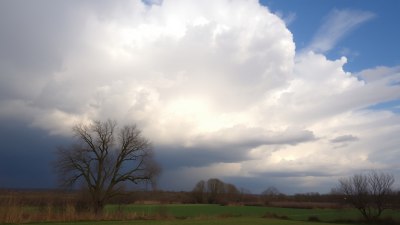Why the Weather Waits Until You're Emotionally Stable to Act Up
Explore why weather often changes during calm emotional moments, revealing unexpected connections between mood and nature's moods.

Image created with Flux Schnell
Have you ever noticed how the weather often seems to shift just when you feel emotionally grounded? It’s a curious phenomenon that many people experience, sensing a sudden storm or a burst of sun aligning strangely with their feelings. While it might seem coincidental, there are interesting reasons why weather might appear to 'wait' until your emotional state is stable before it acts up. This intersection between human emotions and atmospheric conditions offers an intriguing glimpse into how we perceive our environment and how nature unfolds around our internal mood landscape.
The Psychological Perception of Weather
First, it’s essential to understand how human psychology shapes our interpretation of weather patterns. Weather itself is a continuous process governed by atmospheric physics with no connection to individual human experiences. However, the way we perceive and react to weather can be heavily influenced by our emotional state. When we are stressed or emotionally turbulent, we might pay less attention to subtle changes in the atmosphere or might interpret constant weather patterns through a lens of personal discomfort. On the other hand, during emotional calm or stability, we may become more sensitive to weather shifts, noticing and even anticipating them more keenly.
This effect can create a perception that weather 'waits' for us to be emotionally stable. It’s not that the clouds or the wind read our moods, but that our own sensory filters and emotional bandwidth adjust, making us more attuned to environmental changes at specific times.
Weather’s Inherent Variability Versus Human Emotional States
Atmospheric conditions, such as changes in temperature, barometric pressure, humidity, and wind, operate on natural cycles and random variabilities often unrelated to local human activities or emotions. The complexity of weather systems means changes can be abrupt or gradual, obvious or subtle, but by their very nature, they do not coordinate with human feelings.
However, since human beings are pattern-seeking animals, they often connect unpredictable weather with personal life events or internal emotional shifts. Our survival instinct makes us look for control and meaning, so linking mood stability with weather pattern changes is a natural mental exercise. This cognitive connection can make it seem as if the weather pauses until we're emotionally ready, adding a poetic rhythm to our interaction with nature.
The Role of Seasonal Affective Patterns and Mood Cycles
Biological and environmental rhythms influence both weather and human emotions. Seasonal shifts, like summers with longer daylight or winters with reduced sun exposure, can impact mood levels, energy, and emotional resilience. Seasonal affective disorder (SAD) is a clinical example of how weather patterns influence emotional states, with many people experiencing depression or lethargy during cloudy, cold months. Conversely, clear, sunny days often uplift mood and enhance emotional stability.
So, the apparent waiting game of the weather could be partly explained by the overlapping cycles of environmental conditions and internal emotional rhythms. When you feel emotionally grounded, it might coincide with weather conditions that are naturally in flux, making the changes stand out more.
Physiological Responses to Weather and Emotional Stability
Human physiology is deeply intertwined with weather elements. Changes in barometric pressure can affect joint pain or headache frequency in some individuals, which in turn impact mood and emotional stability. Similarly, temperature variations can influence energy metabolism and sleep quality, both crucial for regulating emotions.
When you are emotionally stable, your body may be better equipped to withstand environmental stressors. This enhanced resilience makes atmospheric changes more noticeable because they contrast with your calm inner state, highlighting weather's fluctuations against your baseline.
Weather as a Metaphor for Emotional States in Culture
Throughout history, weather has served as a powerful metaphor for human emotions in literature, art, and daily speech. Storms symbolize turmoil or conflict; sunshine represents joy and hope; fog implies confusion or uncertainty. This cultural symbolism reinforces the human tendency to link weather changes with emotional experiences.
This association may subconsciously shape our expectations about when and how weather shifts occur relative to our mood states. If you anticipate a mood storm to be followed by emotional calm, then perhaps you also expect the weather to echo that transition, enhancing the perception that it waits for you to stabilize emotionally.
The Science Behind Weather Timing and Emotional Awareness
Scientifically, weather changes follow physical laws involving solar radiation, atmospheric pressure systems, humidity, and geography. These systems evolve over hours or days independently of any individual’s emotional state. However, emotional awareness and mindfulness practices can heighten our sensitivity to environmental conditions, including weather. When emotionally stable, people can better observe and interpret the subtle signs of weather changes such as shifts in wind direction or subtle temperature drops, which might go unnoticed during emotional upheaval.
This enhanced awareness does not mean weather alters to fit emotional patterns but highlights the human capacity for perception and interpretation within natural phenomena.
Emotional Resilience and Weather Preparedness
Interestingly, people with greater emotional resilience often display better coping mechanisms for adverse weather conditions. When emotionally stable, one can engage in proactive preparations instead of reactive responses to sudden storms or heat waves. This preparedness might create a psychological illusion that weather events 'wait' until one is ready because calmness precedes conscious action and adaptation.
In contrast, during emotional distress, individuals may feel overwhelmed and less attentive to weather changes, making sudden weather shifts feel more disruptive and out of sync with their state.
Understanding the Synchrony Between Mind and Environment
The idea that weather waits until you are emotionally stable underscores the deeper human desire to find harmony between inner and outer worlds. While scientifically improbable that weather systems respond to emotional states, the subjective experience of this synchrony is very real to many people. It illustrates the profound connection we feel with nature and how environment and mind reflect and influence each other in complex ways.
Being aware of this relationship can deepen one’s appreciation of both emotional health and the natural world, encouraging a mindful coexistence that respects the rhythms of both.
Timing and Perception: When Does the Weather Seem to 'Act Up'?
For many, emotionally challenging moments often coincide with perceptions of stagnant or unchanging weather–gray skies, dull temperatures, or persistent calm. The weather ‘acting up’ often happens during moments of calmness, where the emotional lull allows us to observe meteorological changes that might otherwise go unnoticed amid stress or emotional chaos. Weather ‘acting up’ can manifest as sudden storms, temperature swings, or lightning strikes that feel dramatic in their timing with our internal state, though they result from independent atmospheric dynamics.
This juxtaposition highlights how our emotional landscape mediates our experience of the natural environment, coloring our interpretations of timing and intensity.
How Cultural Beliefs Influence Weather Perception
Cultural narratives and folklore frequently attribute personalities or intent to weather phenomena, believing them reactive to human feelings or behaviors. These beliefs shape the way communities interpret weather patterns and their timing relative to human events. In some traditions, weather anomalies following a period of calm are seen as omens or responses to collective moods.
Such cultural lens reinforces individual perceptions that weather ‘waits’ for emotional stability, embedding this idea into social and psychological frameworks that influence how we experience and speak about weather’s timing and meaning.
Mindfulness Practices Enhancing Awareness of Weather and Emotions
Engaging in mindfulness can improve the ability to notice subtle changes in weather and internal emotional states concurrently. Practices like meditation, deep breathing, and nature walks heighten present-moment awareness, enabling individuals to detect connections between mood and atmosphere. This enhanced sensitivity may reveal patterns previously unnoticed, contributing to the sense that weather reacts to emotional balance moments.
While not a causative relationship, the parallel observation of weather’s moods alongside one’s own inner calm fosters a richer, more nuanced relationship with nature.
Weather, Emotional Stability, and Decision Making
Emotional stability often sharpens judgment and decision-making skills, which can influence how one responds to changing weather. For example, a calm person is more likely to prepare appropriately for approaching storms or heat waves, while someone in emotional distress might disregard weather warnings or fail to plan for environmental changes. This difference can enhance the impression that weather ‘waits’ for emotional readiness, as stability primes proactive engagement with environmental considerations.
Perspectives from Environmental Psychology
Environmental psychology explores how surroundings interact with human behavior and mental processes. It demonstrates that natural elements like weather do impact mood and cognition, contributing subtly to emotional fluctuations. For example, bright sunny days have been linked to increased energy and positive emotions, while gloomy weather can lower mood and increase irritability. This reciprocal interaction provides a framework for understanding why weather changes are particularly noticeable during times of emotional calm, when our psychological filters are more open to external stimuli.
Weather Phenomena That Align with Emotional Shifts
Certain weather events are more dramatic and memorable, often occurring alongside or shortly after periods of emotional calm or reflection. Thunderstorms, sudden temperature drops, or wind gusts can echo internal shifts toward equilibrium. This alignment makes such events stand out in memory, reinforcing the perception of intentional timing by the weather system.
Can Weather Influence Emotional Stability?
While the initial prompt suggests the weather waits on emotional stability, it is also true that weather can influence emotions profoundly. Sunny skies can elevate mood quickly, whereas overcast or stormy days may contribute to sadness or anxiety. This bidirectional relationship between environment and mind complicates the notion of waiting by intertwining cause and effect in complex feedback loops. Emotional stability might arise partly due to weather conditions, which then illuminate weather's changes through heightened awareness.
Practical Strategies to Harmonize Emotions and Weather
Recognizing the interplay between emotional states and weather perception can help individuals foster resilience and harmony with their environment. Techniques include:
- Acknowledging the current emotional state without judgment
- Observing weather changes as natural phenomena rather than personal omens
- Using mindfulness to stay present with both internal moods and external conditions
- Preparing practically for weather changes regardless of emotional state
- Engaging with nature daily to cultivate a balanced connection
These practices dismantle the narrative that weather must 'wait' for emotional readiness by promoting simultaneous acceptance and adaptation.
The experience that weather acts up when you are emotionally stable arises from psychological perception, biological rhythms, cultural interpretations, and heightened awareness rather than any underlying causal link. Emotional stability sharpens our sensory abilities, making weather changes more salient. Cultural narratives and environmental psychology reinforce these connections, creating a potent subjective reality.
By embracing this understanding, one can deepen appreciation for both personal emotional cycles and the dynamic world of weather, realizing that each informs and reflects the other without direct control.











